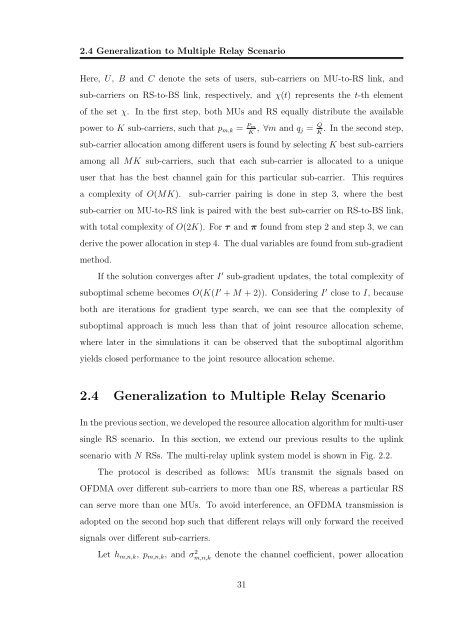Resource Allocation in OFDM Based Wireless Relay Networks ...
Resource Allocation in OFDM Based Wireless Relay Networks ...
Resource Allocation in OFDM Based Wireless Relay Networks ...
Create successful ePaper yourself
Turn your PDF publications into a flip-book with our unique Google optimized e-Paper software.
2.4 Generalization to Multiple <strong>Relay</strong> Scenario<br />
Here, U, B and C denote the sets of users, sub-carriers on MU-to-RS l<strong>in</strong>k, and<br />
sub-carriers on RS-to-BS l<strong>in</strong>k, respectively, and χ(t) represents the t-th element<br />
of the set χ. In the first step, both MUs and RS equally distribute the available<br />
power to K sub-carriers, such that p m,k = P m<br />
K<br />
, ∀m and q j = Q . In the second step,<br />
K<br />
sub-carrier allocation among different users is found by select<strong>in</strong>g K best sub-carriers<br />
among all MK sub-carriers, such that each sub-carrier is allocated to a unique<br />
user that has the best channel ga<strong>in</strong> for this particular sub-carrier. This requires<br />
a complexity of O(MK).<br />
sub-carrier pair<strong>in</strong>g is done <strong>in</strong> step 3, where the best<br />
sub-carrier on MU-to-RS l<strong>in</strong>k is paired with the best sub-carrier on RS-to-BS l<strong>in</strong>k,<br />
with total complexity of O(2K). For τ and π found from step 2 and step 3, we can<br />
derive the power allocation <strong>in</strong> step 4. The dual variables are found from sub-gradient<br />
method.<br />
If the solution converges after I ′ sub-gradient updates, the total complexity of<br />
suboptimal scheme becomes O(K(I ′ + M + 2)). Consider<strong>in</strong>g I ′ close to I, because<br />
both are iterations for gradient type search, we can see that the complexity of<br />
suboptimal approach is much less than that of jo<strong>in</strong>t resource allocation scheme,<br />
where later <strong>in</strong> the simulations it can be observed that the suboptimal algorithm<br />
yields closed performance to the jo<strong>in</strong>t resource allocation scheme.<br />
2.4 Generalization to Multiple <strong>Relay</strong> Scenario<br />
In the previous section, we developed the resource allocation algorithm for multi-user<br />
s<strong>in</strong>gle RS scenario. In this section, we extend our previous results to the upl<strong>in</strong>k<br />
scenario with N RSs. The multi-relay upl<strong>in</strong>k system model is shown <strong>in</strong> Fig. 2.2.<br />
The protocol is described as follows: MUs transmit the signals based on<br />
<strong>OFDM</strong>A over different sub-carriers to more than one RS, whereas a particular RS<br />
can serve more than one MUs. To avoid <strong>in</strong>terference, an <strong>OFDM</strong>A transmission is<br />
adopted on the second hop such that different relays will only forward the received<br />
signals over different sub-carriers.<br />
Let h m,n,k , p m,n,k , and σm,n,k 2 denote the channel coefficient, power allocation<br />
31

















